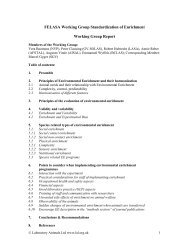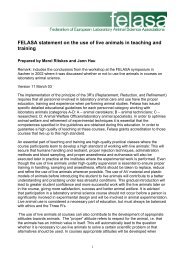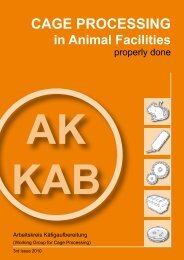CAGE PROCESSING in Animal Facilities - Felasa
CAGE PROCESSING in Animal Facilities - Felasa
CAGE PROCESSING in Animal Facilities - Felasa
- No tags were found...
Create successful ePaper yourself
Turn your PDF publications into a flip-book with our unique Google optimized e-Paper software.
Semi-automaticsystemsmultiple fill<strong>in</strong>g with afixed fill<strong>in</strong>g manifold,automatic identificationand dispens<strong>in</strong>grelatively cost-effective;can be <strong>in</strong>troduced with<strong>in</strong>an exist<strong>in</strong>g facility;timesav<strong>in</strong>gmedium capacity; not the mostsuitable ergonomic optionFully automaticsystemsfully automatic fill<strong>in</strong>gand refitt<strong>in</strong>g of capsby robots or automaticmach<strong>in</strong>estimesav<strong>in</strong>g; ergonomicallybeneficial; highcapacity; reduced staffpossiblevery high <strong>in</strong>vestment costs; possiblelimitations due to the need tostandardise bottles; high ma<strong>in</strong>tenance;requires large space4.5 Steam sterilisationSteam sterilisation has proven its worth as a universal sterilisation procedure <strong>in</strong> animal facilities.4.5.1 Requirements for steam sterilisersSterilisers <strong>in</strong> animal facilities can be necessary for the follow<strong>in</strong>g purposes (as described <strong>in</strong> chapter 2):• to provide sterilised items <strong>in</strong>to specific operational areas (“sterilise <strong>in</strong>”)• to dispose potentially <strong>in</strong>fectious or genetically modified material from specific operation areas to the outside(“sterilise out”).Please f<strong>in</strong>d below a description of different mach<strong>in</strong>e groups, processes, dimensions and technical components.4.5.1.1 Products and materialsFor select<strong>in</strong>g and operat<strong>in</strong>g sterilisers <strong>in</strong> animal facilities, the follow<strong>in</strong>g differences should be considered:• heat-resistant / heat-sensitive,• solids / liquids,• with solids: porous / non porous.Heat-resistant products <strong>in</strong> this case of application are materials that can be steam sterilised at 121 °C for atleast 20 m<strong>in</strong>utes. Heat-sensitive products do not tolerate this temperature (e.g. computers, microscopes, powertools).For safety reasons, solid materials are treated differently from liquid ones (e.g. boil<strong>in</strong>g delay with filled waterbottles). Porous products (e.g. feed bags, cages with bedd<strong>in</strong>g, textiles), require, due to their surface structure,special procedures for air removal and steam penetration. Non porous products possess a flat, closed surfacestructure (e.g. cages, racks, empty water bottles).4.5.1.2 Devices and proceduresSterilisers should meet the requirements specified by the German Institute for Standardization <strong>in</strong> DIN 58951-1(Sterilization – Steam sterilizers for laboratory items). This directive describes different mach<strong>in</strong>e groups. Sterilisersfor animal facilities can be found <strong>in</strong> group D.Depend<strong>in</strong>g on the type of products to be sterilised, sterilisers should permit comb<strong>in</strong>ations of process steps asdescribed <strong>in</strong> the table below:Table 4-8Products Pretreatment Steam sterilisation Aftertreatmentimporous PVP / FVP suitable comb<strong>in</strong>ations of temperature VWDporous FVPand time, e.g. 121 °C with a 20 m<strong>in</strong>hold<strong>in</strong>g timeVWDliquid PVP ICBPwaste/GMO FVP VWOD / VWDanimal carcass FVP PRAP / VWODCage Process<strong>in</strong>g <strong>in</strong> <strong>Animal</strong> <strong>Facilities</strong> · 4th issue · 2013 29






